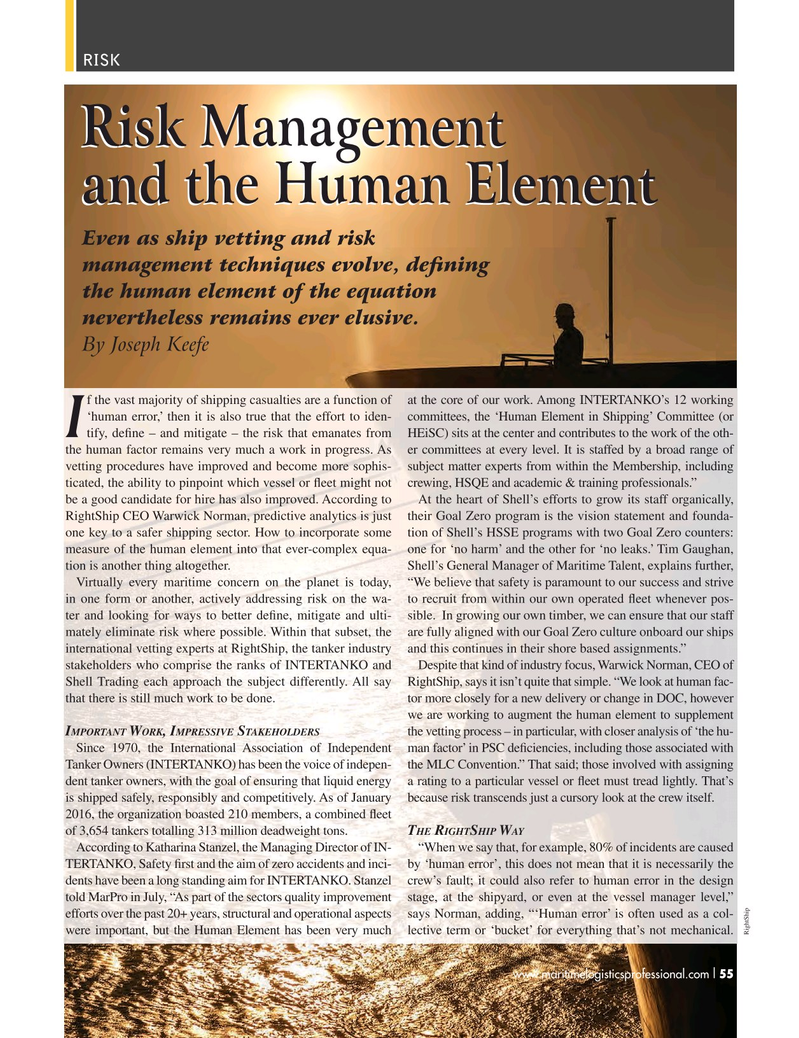
Page 55: of Maritime Logistics Professional Magazine (Q3 2016)
Shipbuilding, Repair & Maintenance
Read this page in Pdf, Flash or Html5 edition of Q3 2016 Maritime Logistics Professional Magazine
RISK
Risk Management Risk Management and the Human Elementand the Human Element
Even as ship vetting and risk management techniques evolve, de? ning the human element of the equation nevertheless remains ever elusive.
By Joseph Keefe f the vast majority of shipping casualties are a function of at the core of our work. Among INTERTANKO’s 12 working ‘human error,’ then it is also true that the effort to iden- committees, the ‘Human Element in Shipping’ Committee (or tify, de? ne – and mitigate – the risk that emanates from HEiSC) sits at the center and contributes to the work of the oth-
I the human factor remains very much a work in progress. As er committees at every level. It is staffed by a broad range of vetting procedures have improved and become more sophis- subject matter experts from within the Membership, including ticated, the ability to pinpoint which vessel or ? eet might not crewing, HSQE and academic & training professionals.” be a good candidate for hire has also improved. According to At the heart of Shell’s efforts to grow its staff organically,
RightShip CEO Warwick Norman, predictive analytics is just their Goal Zero program is the vision statement and founda- one key to a safer shipping sector. How to incorporate some tion of Shell’s HSSE programs with two Goal Zero counters: measure of the human element into that ever-complex equa- one for ‘no harm’ and the other for ‘no leaks.’ Tim Gaughan, tion is another thing altogether. Shell’s General Manager of Maritime Talent, explains further,
Virtually every maritime concern on the planet is today, “We believe that safety is paramount to our success and strive in one form or another, actively addressing risk on the wa- to recruit from within our own operated ? eet whenever pos- ter and looking for ways to better de? ne, mitigate and ulti- sible. In growing our own timber, we can ensure that our staff mately eliminate risk where possible. Within that subset, the are fully aligned with our Goal Zero culture onboard our ships international vetting experts at RightShip, the tanker industry and this continues in their shore based assignments.” stakeholders who comprise the ranks of INTERTANKO and Despite that kind of industry focus, Warwick Norman, CEO of
Shell Trading each approach the subject differently. All say RightShip, says it isn’t quite that simple. “We look at human fac- that there is still much work to be done. tor more closely for a new delivery or change in DOC, however we are working to augment the human element to supplement the vetting process – in particular, with closer analysis of ‘the hu-
I W , I SMPORTANT ORK MPRESSIVE TAKEHOLDERS
Since 1970, the International Association of Independent man factor’ in PSC de? ciencies, including those associated with
Tanker Owners (INTERTANKO) has been the voice of indepen- the MLC Convention.” That said; those involved with assigning dent tanker owners, with the goal of ensuring that liquid energy a rating to a particular vessel or ? eet must tread lightly. That’s is shipped safely, responsibly and competitively. As of January because risk transcends just a cursory look at the crew itself.
2016, the organization boasted 210 members, a combined ? eet of 3,654 tankers totalling 313 million deadweight tons. T R S WHE IGHT HIP AY
According to Katharina Stanzel, the Managing Director of IN- “When we say that, for example, 80% of incidents are caused
TERTANKO, Safety ? rst and the aim of zero accidents and inci- by ‘human error’, this does not mean that it is necessarily the dents have been a long standing aim for INTERTANKO. Stanzel crew’s fault; it could also refer to human error in the design told MarPro in July, “As part of the sectors quality improvement stage, at the shipyard, or even at the vessel manager level,” efforts over the past 20+ years, structural and operational aspects says Norman, adding, “‘Human error’ is often used as a col- were important, but the Human Element has been very much lective term or ‘bucket’ for everything that’s not mechanical.
RightShip www.maritimelogisticsprofessional.com 55I 50-63 Q3 MP2016.indd 55 8/17/2016 10:28:09 AM

 54
54

 56
56
